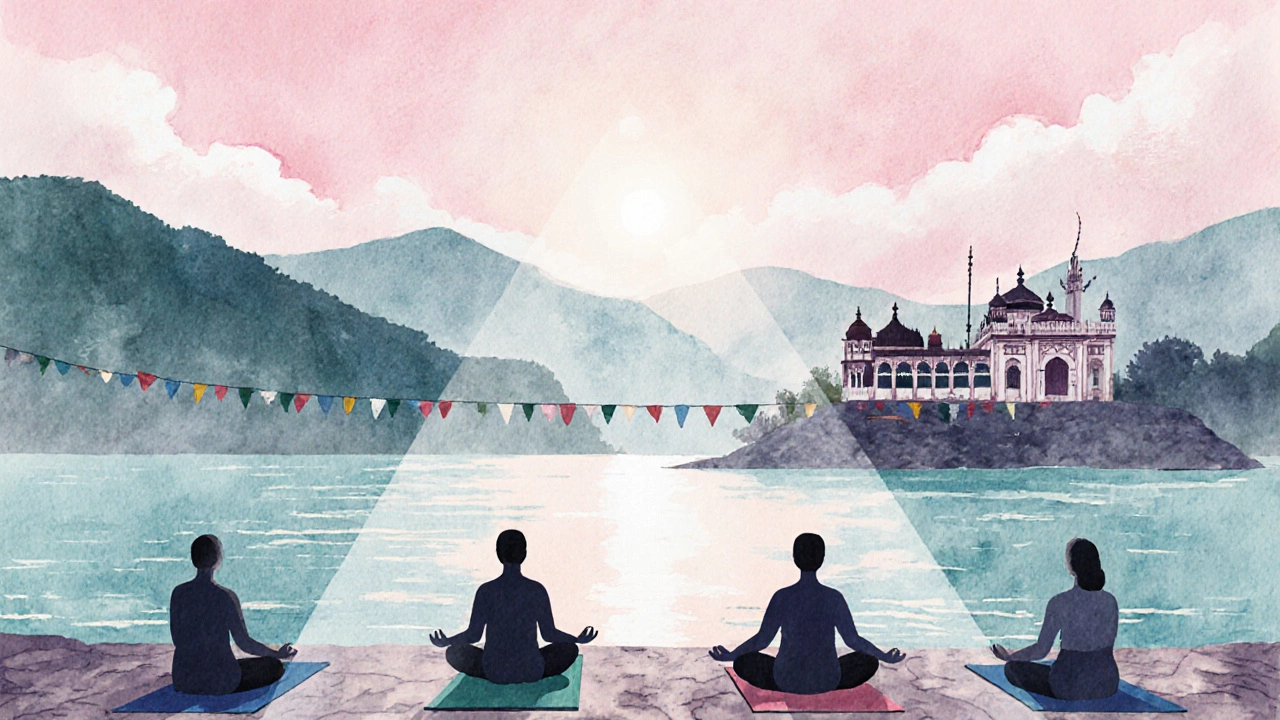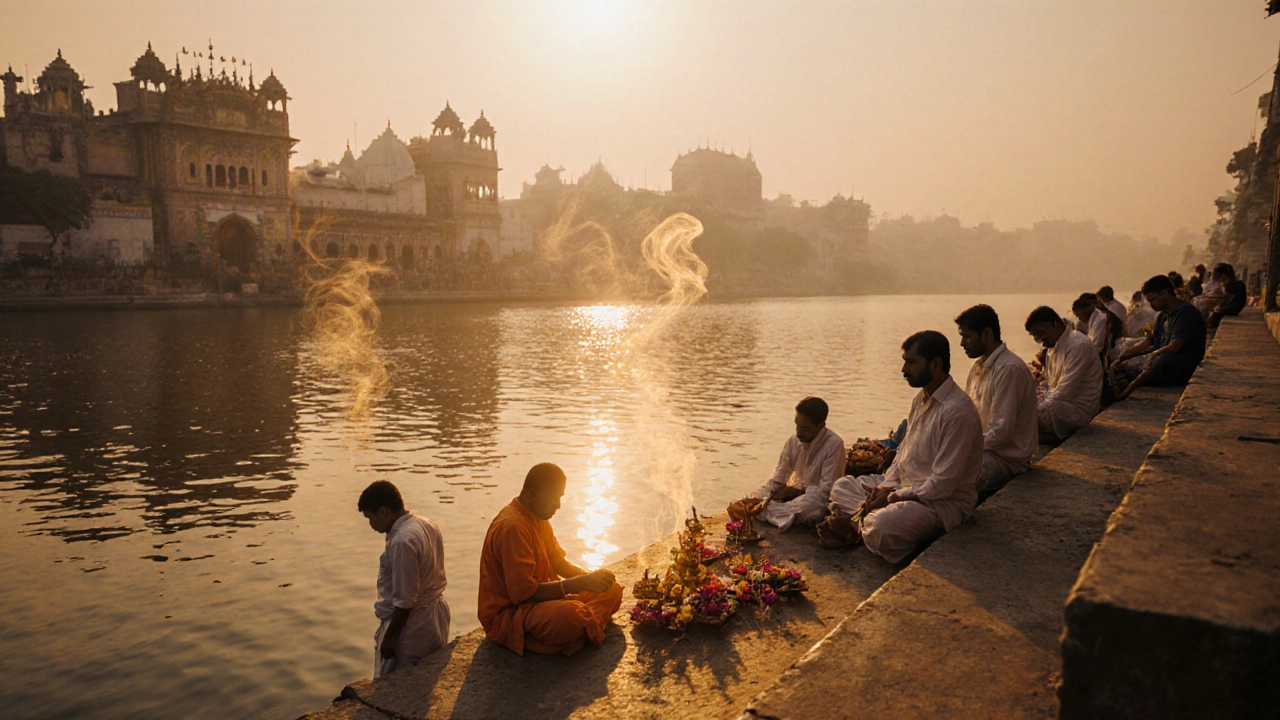India Spiritual Destination Finder
Find Your Spiritual Match
Select your interests to see which Indian spiritual destinations best match your needs.
Your Spiritual Matches
Key Takeaways
- India’s top spiritual hotspots include Varanasi, Rishikesh, Tirupati, Amritsar, Haridwar, Puri, Kedarnath, and Sikkim.
- Each destination offers a unique blend of history, rituals, and natural settings that deepen spiritual experience.
- Best visiting seasons vary-most places shine between October and March, while coastal spots sparkle in winter.
- Travel tips cover transport, accommodation, and etiquette to help you absorb the vibe without a hitch.
- A quick comparison table lets you match your interests (Hindu pilgrimage, Sikh heritage, Buddhist retreat) with the right spot.
Why India Feels Like the World’s Spiritual Hub
India has been a crossroads of faith for millennia. From the Vedic chants echoing along the Ganges to the serene chants of Buddhist monks in the Himalayas, the subcontinent stitches together countless belief systems. That layered history means you can walk out of a bustling market and step into a centuries‑old temple or a quiet ashram in the same breath. This density of sacred sites makes the country feel alive with an energy that many travelers call "spiritual".
Top Spiritual Destinations - What Makes Them Special
Below are the eight places that consistently top pilgrim and traveler lists. They each have a distinct flavor, yet all share a deep‑rooted sense of the divine.
When you picture the ultimate spiritual city, most think of Varanasi - the ancient city on the banks of the Ganges, revered as the spiritual capital of Hinduism. Here, sunrise rituals on the ghats, the scent of incense, and the sound of Sanskrit chants blend into a living tapestry of devotion. The belief is that dying in Varanasi frees the soul from the cycle of rebirth.
Just a few hours north, Rishikesh - the "Yoga Capital of the World" perched on the foothills of the Himalayas draws seekers for its ashrams, yoga schools, and the iconic Ganga Aarti at Triveni Ghat. The river’s rush adds a meditative backdrop, and the surrounding forest offers silence that’s hard to find in a city.
If you travel south, Tirupati - the home of Lord Venkateswara’s temple in Andhra Pradesh, drawing over 50 million devotees annually stands out. The temple’s golden gopuram glitters against a hill backdrop, and the long queue, known as the "Mandalay", is a test of patience and faith alike.
For Sikh spirituality, Amritsar - the city that houses the Golden Temple, the holiest shrine of Sikhism offers a unique communal vibe. The temple’s four doors symbolize openness, and the free kitchen (langar) serves meals to thousands daily, embodying equality.
Another Hindu hotspot, Haridwar - the gateway to the Himalayas where the Ganges exits the mountains, mirrors Varanasi’s night‑time Aarti but in a more relaxed, small‑town setting. The Kumbh Mela, held every twelve years, transforms the city into a massive spiritual convergence.
On the eastern coast, Puri - the sacred city of Odisha famous for Jagannath Temple and its annual Rath Yatra blends seaside breezes with temple chants, creating a contrast few places can match.
High up in the Himalayas, Kedarnath - one of the twelve Jyotirlingas, perched at 3,583 meters and accessible only by foot, offers a pilgrimage that’s as much about physical endurance as inner devotion. The snow‑capped backdrop amplifies the feeling of being close to the divine.
Finally, for a more eclectic spiritual experience, Sikkim - the northeastern state where Buddhist monasteries, Hindu temples, and pristine valleys coexist presents a calm, mountaintop vibe. Places like Rumtek Monastery and the Enchey Monastery provide meditation retreats away from the crowds.

How to Choose the Right Spot for Your Journey
Think about what draws you most: intense ritual, serene nature, community service, or a mix. Below is a quick guide:
- Ritual intensity: Varanasi, Haridwar, Kedarnath.
- Yoga & wellness: Rishikesh, Sikkim.
- Community & service: Amritsar (langar), Tirupati (donations).
- Coastal spirituality: Puri.
Also consider logistics. Varanasi and Amritsar have major airports and good train links, while Kedarnath requires a trek after reaching Gaurikund. Weather matters: Himalayan sites are best in October‑December, whereas southern sites stay pleasant year‑round.
Practical Tips for Visiting Sacred Sites
Dress modestly - most temples expect covered shoulders and knees. Remove shoes before entering shrines. Bring a small donation box if you feel inclined; it’s usually appreciated.
Timing matters: early morning Aarti at Varanasi or Haridwar is magical, but you’ll face crowds. For a quieter vibe, visit late afternoon or on a weekday.
Stay hydrated, especially in desert‑like Rajasthan or high‑altitude Kedarnath. Local guesthouses often offer vegetarian meals that align with spiritual customs.
Comparison of India’s Top Spiritual Destinations
| Destination | Primary Religion | Signature Sacred Site | Best Visiting Season | Unique Spiritual Experience |
|---|---|---|---|---|
| Varanasi | Hinduism | Kashi Vishwanath Temple | Oct‑Mar | Ganga Aarti at sunset |
| Rishikesh | Hinduism/Yoga | Triveni Ghat | Oct‑Mar | Yoga retreats & riverside meditation |
| Tirupati | Hinduism | Venkateswara Temple | Oct‑Feb | Divine Darshan after long queue |
| Amritsar | Sikhism | Golden Temple | Oct‑Mar | Participate in langar (community kitchen) |
| Haridwar | Hinduism | Mansa Devi Temple | Oct‑Mar | Evening Ganga Aarti |
| Puri | Hinduism | Jagannath Temple | Oct‑Feb | Rath Yatra (Chariot Festival) |
| Kedarnath | Hinduism | Kedarnath Temple | Jun‑Sep | High‑altitude pilgrimage trek |
| Sikkim | Buddhism/Hinduism | Rumtek Monastery | Oct‑Mar | Monastic meditation retreats |
Stories From the Road: Real Traveler Moments
One solo traveler from Canada wrote that standing on Varanasi’s ghats at dusk felt like watching the universe breathe. Another group of yoga enthusiasts said the sunrise yoga session on Rishikesh’s banks gave them a "spiritual reset" they hadn’t felt in years.
In Amritsar, a visitor described the moment the holy water touched his hands at the Golden Temple as "pure bliss"-the kind of feeling you can’t capture in photos, only in memory.
Frequently Asked Questions
Which Indian spiritual destination is best for first‑time visitors?
Varanasi offers a vivid blend of ceremony, history, and accessibility, making it an excellent starter. Haridwar and Amritsar are also friendly for newcomers because of good transport links and well‑organized facilities.
Do I need a visa to visit these sacred places?
Yes. All foreign travelers need an Indian visa. The e‑visa process is quick and works for pilgrimages, tourism, and short stays.
What should I wear at temples and gurudwaras?
Modest, clean clothing is key. For Hindu temples, cover shoulders and knees. In Sikh gurudwaras, remove shoes and cover your head (a scarf works). Avoid leather items, as many sites discourage them.
Can I photograph the rituals?
Usually you can, but be respectful. Some ceremonies, especially private ones, restrict photography. Look for signs or ask a local guide before snapping.
Is it safe to travel alone to these places?
Most major spiritual sites are well‑policed and have accommodations for solo travelers. Stick to popular areas, use reputable transport, and keep valuables secure.
Next Steps - Planning Your Spiritual Journey
1. Choose a destination that matches your spiritual goal (ritual, meditation, community service).
2. Check the best season and book flights/rail tickets early, especially for peak pilgrimage months.
3. Reserve a stay near the main shrine-most cities have guesthouses, ashrams, or budget hotels within walking distance.
4. Pack modest clothing, a reusable water bottle, and a small amount of cash for offerings or donations.
5. Arrive with an open mind. Let the local chants, smells, and rhythms guide your experience.
India’s spiritual tapestry is vast, but you don’t need to see it all at once. Pick one spot, immerse fully, and you’ll leave with a story that feels like a personal pilgrimage. Whether you’re chasing the echo of a Ganga Aarti or the silence of a Himalayan monastery, the journey itself often becomes the most profound lesson.
spiritual places India offer more than sightseeing-they invite you to pause, reflect, and perhaps discover a piece of yourself you didn’t know was missing.
